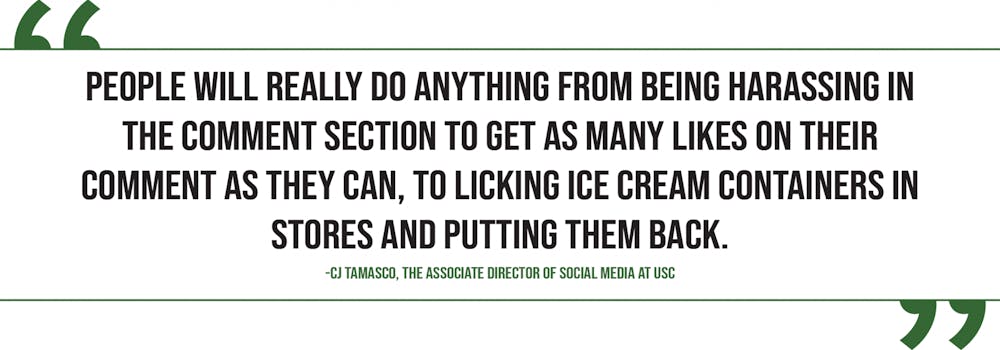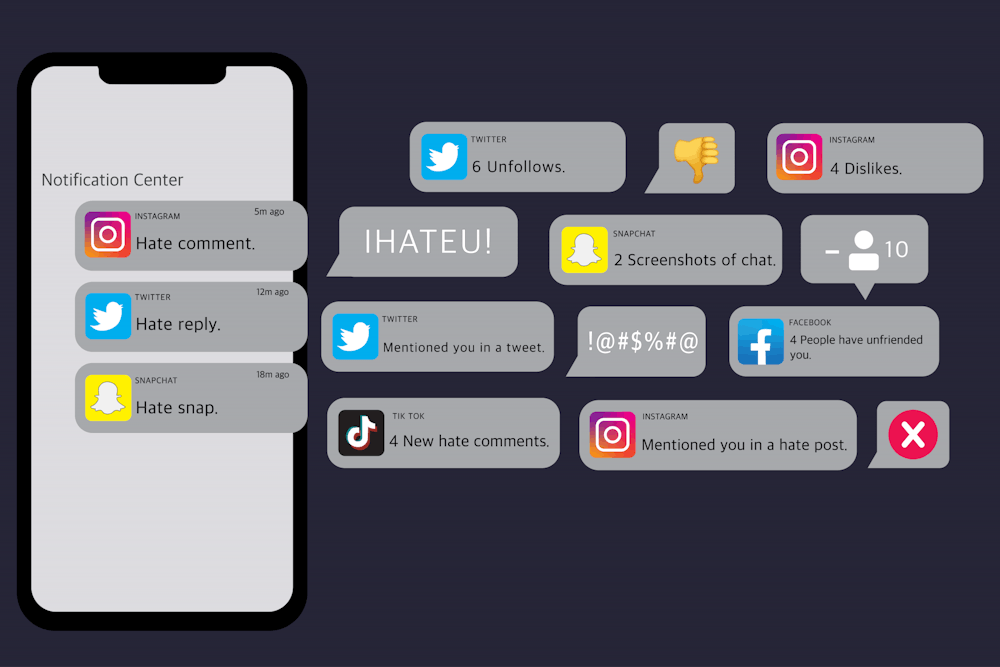Many individuals have become disconnected from reality as a result of viral culture. This disconnect can lead to a lack of empathy and an eagerness for validation on social media.
Viral culture is social media content that is quickly shared, often with the hopes of achieving viral fame.
Certain users on platforms such as TikTok and Twitter post vicious and insensitive content that pursues views and likes at the expense of others' feelings.
Those who create offensive content often refer to it as "dark humor," which utilizes someone else's suffering to promote popularity on social media. This kind of culture has become somewhat routine.
“Whatever moral compass (users) had, they’ll throw it out the window if that means that they can become famous, even if it’s for a little bit,” third-year journalism student Chanel Owens said. “They want to say the most controversial thing possible just so they can get the most reactions …even if what they’re saying, they know is so wrong and disrespectful.”
Though social media platforms aren't typically advertised as a safe haven for users, it appears that some users have lost sight of what it means to be a decent human being. This is a result of the disconnect that comes from spending too much time in front of a screen.
When users forget how to address others appropriately, hateful commentary on social outlets becomes more common. Even if you can't see their face, it's important for users to remember that another user is a human being, not just an account.
CJ Tamasco, the associate director of social media at USC, said the current viral culture on social media is "dangerous."
“People will really do anything from being harassing in the comment section to get as many likes on their comment as they can, to licking ice cream containers in stores and putting them back,” Tamasco said.

Instead of doing or saying these things in public and risking accountability, many users feel safer doing or saying them on social platforms.
“You can anonymize yourself," graduate psychology student Wendy Chu said. "You can have a voice in this digital space without it being connected to who you are because no one is going to know who ‘usernamehappybunny’ is, right? But ‘happybunny’ can say whatever they want and have a reaction.”
At the expense of the victims and those who may be triggered, jokes about traumatic occurrences are often made. Although anything can technically offend anyone, social media users sometimes seem to post content with the intention of being hateful to attract views and promote engagement.
“(Users are) going to do the most outrageous thing or whatever it is to grab people’s attention in this sea of information,” Chu said.
An example of this is when many TikTok users misused the voice of Taraji P. Henson from the film "Hidden Figures," distorting the context of the sound, which was originally meant to fight against racism. Users compared the dialogue in this film, which shows Henson reacting to institutional racism at her place of work, to unmeasurable circumstances such as complaining about household chores.
Another example is the Netflix series about serial killer Jeffrey Dahmer, which prompted trends, jokes and even a dance move called "the Dahmer," while completely ignoring the severity of the situation.
“Jeffrey Dahmer — that’s a good example where people are almost dehumanizing the victims because they have this level of being removed from it because it’s something they’re being exposed to online through social media,” Nada Goodrum, an assistant professor of psychology at USC, said.
This Netflix "documentary" gave some users an excuse to sympathize with a serial killer by dramatizing and romanticizing an actual occurrence. These trends and documentaries are dangerous because not everyone can understand the gravity of what the victims and their families have gone through.
Viral culture has led to an underestimation of tragic events and the reliving of trauma. Even if someone is harmed in the process, it doesn't matter as long as the content promotes engagement or receives a lot of views.
Another detrimental effect of viral culture is the way we perceive ourselves.
Beauty trends popularized by viral culture are created to manipulate the content that users post, in the hopes of increasing their own popularity and/or excluding others. Those who are fixated on these beauty trends, standards and public validation can easily develop unhealthy habits as a result.
“It’s like you’re comparing your insides to other people’s outsides,” Goodrum said. “You are looking at how people portray themselves on social media and it could lead to negative self-evaluation.”
Social media is mainly flooded with content that showcases the best view of someone's appearance. It is very damaging to impose a specific standard on users, which most people will not even meet.
This causes many individuals to use likes, views and other forms of social engagement to measure their worth. Owens believes that users may seek this validation online to fill a void within.
“When they figure out that they can’t fill it, then they spiral and they just keep doing these same, destructive things,” Owens said.
As a result of viral culture, individuals determine each other's value based on their number of followers and likes as well as adherence to beauty trends that were created with the intention of oppressing others.
Users regard themselves as unworthy if they do not have a certain appearance or level of popularity, rather than as actual human beings with purposes beyond these factors.
Viral culture on social media continues to push the agenda that you have to be or look a certain way to be deserving of respect and basic kindness.
“And often what (users are) seeing put out there on social media is very curated and might not be a really accurate representation of what someone is like, but they’re still seeing it as the standard to compare themselves to,” Goodrum said.
It is our responsibility as social media consumers to stop allowing viral culture to shape our ideas of value, worth and beauty. The way we use these platforms is a major factor in how they may affect us.
To avoid these issues, users must understand how to use social media and be aware of how they can harm themselves and others. Knowing one's limit and being aware of what is commented, shared or posted can help users avoid disconnection, lack of empathy and the need for validation.

